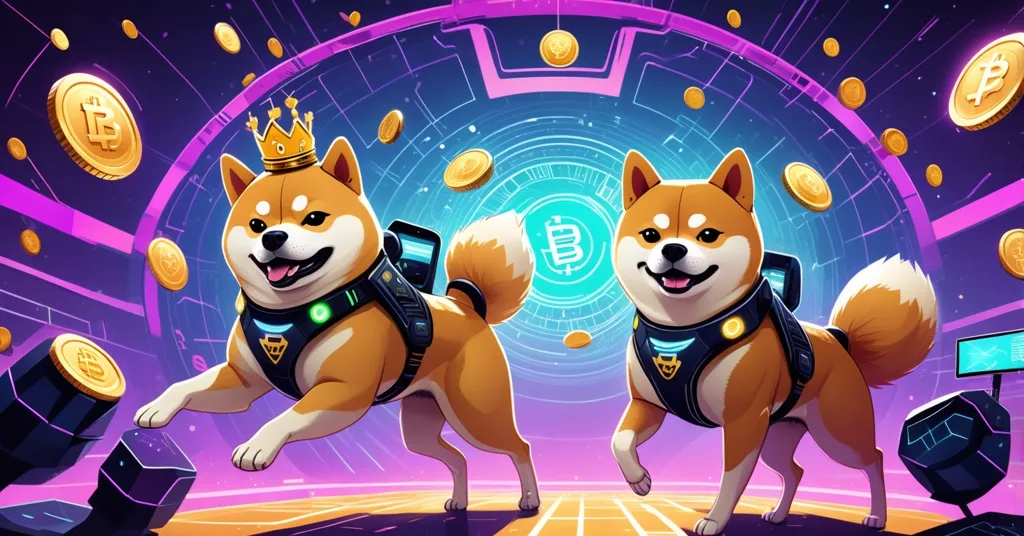LayerBrett vs. Dogecoin: Meme Coin Battle for 2025 Dominance Heats Up

LayerBrett Challenges Dogecoin’s Reign: The Meme Coin Showdown for 2025
The meme coin market is heating up as we look toward 2025, and a new contender, LayerBrett (LBRETT), is clawing at Dogecoin’s long-held dominance with bold tech claims and staggering promises. But can it dethrone the OG meme king, or are established players like DOGE—and underdogs like Pepe, Floki Inu, and Bonk—still the safer bets in this chaotic crypto casino? Let’s unpack the hype, the risks, and the raw reality.
- LayerBrett (LBRETT) leads the 2025 hype with a layer-2 Ethereum solution and unreal staking rewards over 20,000% APY.
- Dogecoin (DOGE) shows cracks with price dips, but its massive community could keep it on top.
- Floki Inu, Pepe, and Bonk battle relevance with shaky traction, tentative recovery, and steep losses.
- Market Risks loom large with regulatory scrutiny and saturation threatening the meme coin frenzy.
LayerBrett’s Big Swing: Tech Innovation or Marketing Mirage?
Meme coins have always been the Wild West of crypto—a space where a viral tweet or a cute dog can turn pocket change into a fortune, or torch it just as fast. LayerBrett (LBRETT) is the latest to ride this wave, but it’s pitching something different: actual utility. Built as a layer-2 solution on Ethereum, it claims to tackle the blockchain’s infamous congestion and sky-high gas fees. For the unversed, Ethereum’s mainnet can feel like a crowded city street during rush hour—slow and expensive. Layer-2 solutions are like bypass roads, processing transactions faster and cheaper while still tapping into Ethereum’s robust security. Think of projects like Arbitrum or Optimism, which have already proven this model. If LayerBrett pulls this off, it could be a game-changer for a meme coin, blending internet humor with real-world function.
The numbers are juicy, too. Its presale reportedly raised over $500,000 in a month, with tokens priced at a dirt-cheap $0.0044. Add to that staking rewards advertised at a mind-blowing 20,000% APY (Annual Percentage Yield, or the yearly return on staked assets), plus a $1 million giveaway to juice community hype, and you’ve got a project screaming for attention. But let’s slam the brakes here. A 20,000% APY? That’s not just ambitious—it’s borderline scam territory until proven otherwise. For context, traditional savings accounts offer 1-5% annually, and even high-yield crypto staking rarely tops 10-20%. Returns this insane often signal a pump-and-dump, where early insiders cash out while latecomers drown in losses. And where’s the proof? There’s no independent audit, no detailed whitepaper, and no transparent developer team to back up these layer-2 claims. Is this a genuine scaling solution or just a meme coin with a fancy label? Without hard evidence, it’s a gamble dressed in tech jargon.
Still, the hype is real. Some corners of the crypto space are buzzing with predictions of 100x returns, and one promotional pitch drives the point home:
Layer Brett is in presale now, but it’s moving fast. Get in early, stake while rewards are high, and don’t miss your shot at the next 100x crypto!
But let’s play devil’s advocate: does utility even matter in meme coins? This market thrives on memes and FOMO, not function. Dogecoin has zero tech edge, yet it’s king. If LayerBrett’s layer-2 story flops with its core audience—who just want a quick moonshot—will the tech angle be a bust? It’s a bold experiment in a space that often laughs at fundamentals, and while we’re all for disrupting finance with innovation, unverified promises are a red flag that should send any sane investor running for the hills. For deeper insights, check out discussions on Ethereum layer-2 meme coin potential.
Dogecoin’s Wobbly Crown: Can It Hold the Throne?
Dogecoin (DOGE), born in 2013 as a Shiba Inu-inspired joke, has been the undisputed heavyweight of meme coins, fueled by a rabid community and celebrity boosts from Elon Musk. Its 2021 bull run saw a peak market cap of $88 billion, driven by Reddit’s WallStreetBets crowd and Musk’s relentless tweeting. Today, though, cracks are showing. Recent price swings and volatility took DOGE to $0.28 before a drop to $0.22, hinting at fading momentum. Technical traders point to a key resistance level at $0.24—a price ceiling where selling pressure often kicks in, pushing the value back down unless buying power breaks through. If it clears that hurdle, analysts see short-term targets of $0.36, mid-term jumps to $0.49, or even wild dreams of $1, pushing a market cap to $150 billion. That’s no small feat for a coin with no major upgrades since 2015.
Yet, DOGE’s strength isn’t tech—it’s culture. Its staying power comes from a community that’s survived crashes newer tokens can’t imagine, plus a market cap that still towers over most rivals. But here’s the flip side: what happens if Musk stops tweeting? Over-reliance on celebrity hype is a shaky foundation, and with fresh projects like LayerBrett stealing the spotlight, 2025 could test whether sentiment alone keeps DOGE atop the heap. Compared to Bitcoin’s store-of-value ethos—a core pillar of financial sovereignty we champion—Dogecoin’s lack of development feels like a silent killer. Still, its resilience can’t be dismissed. It’s weathered storms that would sink most altcoins, and in a hype-driven market, that might just be enough. For more on its trajectory, explore Dogecoin’s market trends and predictions.
The Underdog Pack: Floki, Pepe, and Bonk Scramble for Scraps
While Dogecoin wrestles with its legacy, a slew of underdogs are fighting for relevance, each with quirks and pitfalls. Floki Inu (FLINU), inspired by the Viking-themed Floki character and Shiba Inu lore, flashes occasional price spikes but can’t sustain traction. With a market cap hovering around $1.8 billion (per CoinMarketCap data as of late 2024) and spotty 24-hour trading volumes, investor confidence remains shaky. It lacks a clear niche beyond meme appeal, making it a long shot for 2025 gains unless a viral moment strikes.
Pepe (PEPE), tied to the internet-famous frog meme, has had a brutal 2024 with multiple price corrections that gutted trust. Its market cap sits near $1.5 billion, but recent upticks in trading volume—often hitting $500 million daily—signal a cautious recovery. The price trend is tentatively upward, though volatility looms large. It’s a coin for risk-takers betting on a comeback, but the scars of past dumps are hard to ignore. For broader context on these tokens, look into meme coin investment potential for 2025.
Bonk (BONK), running on Solana’s fast, low-cost blockchain, is in rougher shape, down 30% over the past month with a market cap of about $800 million. Some see this as a discount buy, with daily volumes still respectable at $100-150 million, but others warn that Solana’s own network hiccups and broader market instability could drag it deeper. It’s a speculative play at best, with no major partnerships or community initiatives to bolster confidence right now.
And let’s not forget the broader field—tokens like Little Pepe (LILPEPE), Pudgy Penguins, and even absurdities like Fartcoin are cluttering the meme coin space, each hoping for a sliver of viral glory. Saturation is a real problem; with hundreds of tokens vying for attention, most will crash and burn, leaving investors holding worthless bags. If you’re curious about top contenders, see this list of leading meme coins for 2025.
Meme Coin Madness: Regulatory Risks and Market Saturation in 2025
Beyond individual projects, the meme coin market faces systemic threats that could derail even the hottest picks. Regulatory scrutiny is tightening globally—think India’s punitive crypto tax regime or the EU’s MiCA framework aiming to curb market manipulation. Meme coins, with their history of pump-and-dumps (recall the Squid Game token collapse of 2021, where insiders rugged investors for millions), are prime targets for crackdowns. A heavy-handed move by the SEC or other bodies in 2025 could cool the party faster than a bear market, especially for unverified projects like LayerBrett that scream “too good to be true.”
Market saturation adds another layer of risk. With countless tokens flooding in, the pie of investor attention—and cash—is sliced thinner every day. Most meme coins lack fundamental value, riding on sentiment rather than substance. Even Dogecoin, for all its clout, isn’t immune to a brutal correction if hype fades, as history shows with its post-2021 crashes. As champions of decentralization, we see meme coins as chaotic experiments that push adoption through viral culture—a nod to effective accelerationism in tearing down financial gatekeepers. But let’s be real: 99% of these projects fail, and they often distract from crypto’s core mission of sovereignty that Bitcoin embodies. They democratize access to speculative markets for retail players, sure, but that’s a double-edged sword when losses pile up. For community-driven insights, check out this comparison of LayerBrett and Dogecoin on Reddit.
Key Takeaways and Burning Questions for Meme Coin Investors
- What makes LayerBrett stand out from Dogecoin and other meme coins?
LayerBrett markets itself with real utility as a layer-2 solution on Ethereum, promising scalability with faster, cheaper transactions, plus staking rewards over 20,000% APY. Dogecoin, by contrast, banks solely on community hype with no comparable tech edge, while others like Pepe or Bonk lack such innovation claims. - Is Dogecoin at risk of losing its dominance by 2025?
Yes, price dips from $0.28 to $0.22 and competition from projects like LayerBrett expose vulnerabilities, but DOGE’s cultural footprint and potential breakout above $0.24 resistance could solidify its reign if sentiment holds strong. - Are underdogs like Floki Inu, Pepe, and Bonk viable for 2025 investments?
It’s a gamble—Floki Inu struggles with lasting traction, Pepe shows slow recovery with rising volumes, and Bonk’s 30% drop screams risk, though some might eye it as a bargain if they can stomach the volatility. - How realistic are 100x return predictions for LayerBrett?
These claims are pure speculation, often just marketing fluff. While LBRETT’s presale success grabs headlines, such returns are nowhere near guaranteed in the meme coin casino, especially without audits or transparency. - What bigger risks should meme coin investors brace for in 2025?
Regulatory crackdowns on manipulative schemes, extreme market saturation with countless competing tokens, and the sheer volatility of sentiment-driven assets could wipe out gains for even the most hyped projects.
As we fight for a world where money isn’t shackled to banks, meme coins are both a circus and a battlefield. LayerBrett’s tech twist is intriguing, but without ironclad proof behind those wild APYs and layer-2 boasts, it’s just another high-stakes roll of the dice. Dogecoin, wobbly as it is, still has the grit to outlast flash-in-the-pan rivals, while the underdog pack rolls with shaky odds. Play if you dare, but never forget the stakes—your wallet’s on the line in this mad dash for crypto glory.



